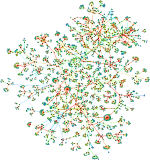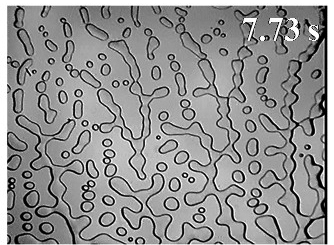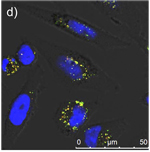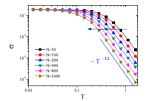News
EPJ Data Science Highlight - What 15 years of mobile data can say about us
- Details
- Published on 05 August 2015

© Blondel et al.
Mobile communication has not shrunk the world as expected, according to an overview of big data analysis revealing the nature of our social interactions with greater accuracy than ever before.
Large-scale anonymised datasets from mobile phones can give a better picture of society than ever before available. Mobile phone use helps us understand social networks, mobility and human behaviour. A review article recently published in EPJ Data Science highlights the main contributions in the field of mobile phone datasets analysis in the past 15 years. Vincent Blondel from the Université Catholique de Louvain, in Belgium, and colleagues conclude, among other things, that predictions that the world would shrink into a small village have not completely materialised as distance still plays a role. Meanwhile, individuals appear to have highly predictable movements as populations evolve in a remarkably synchronised way.
EPJ E Colloquium: Adhesion induced pattern formation in constrained soft films
- Details
- Published on 31 July 2015

© Chaudhury et al.
A hydrostatically-stressed soft elastic film responds by developing a morphological instability, the wavelength of which is dictated by minimisation of the surface and elastic strain energies of the film. For a single film, the wavelength of this transition is entirely dependent on the film's thickness, however in the case of two contacting films a co-operative energy minimisation dictates that the wavelength depends on both the elastic moduli and the thicknesses of the two films.
EPJ B Highlight - Shaping the hilly landscapes of a semi-conductor nanoworld
- Details
- Published on 30 July 2015

A new study reveals how hexagonal-patterned, self-organised hill structures emerge in 2D at the nanoscale due to redeposition following semi-conductor bombardment with low-energy ions
Nanoscale worlds sometimes resemble macroscale roller-coaster style hills, placed at the tip of a series of hexagons. Surprisingly, these nanohills stem from the self-organisation of particles – the very particles that have been eroded and subsequently redeposited following the bombardment of semi-conductors with ion beams. Now, a new theoretical study constitutes the first exhaustive investigation of the redeposition effect on the evolution of the roughening and smoothing of two-dimensional surfaces bombarded by multiple ions. The results demonstrate that the redeposition can indeed act as stabilising factor during the creation of the hexagonally arranged dot patterns observed in experiments. These findings by Christian Diddens from the Eindhoven University of Technology, in the Netherlands, and Stefan Linz, from Munster University, Germany, have been published in a study published in EPJ B.
EPJ Quantum Technology Highlight - Gold-diamond nanodevice for hyperlocalised cancer therapy
- Details
- Published on 29 July 2015

Gold nanorods can be used as remote controlled nanoheaters delivering the right amount of thermal treatment to cancer cells, thanks to diamond nanocrystals used as temperature sensors
Precise targeting biological molecules, such as cancer cells, for treatment is a challenge, due to their sheer size. Now ,Taiwanese scientists have proposed an advanced solution, based on a novel combination of previously used techniques, which can potentially be applied to thermal cancer therapy. Pei-Chang Tsai from the Institute of Atomic and Molecular Sciences, at the Academia Sinica, Taipei, and colleagues just published in EPJ QT an improved sensing technique for nanometre-scale heating and temperature sensing. Using a chemical method to attach gold nanorods to the surface of a diamond nanocrystal, the authors have invented a new biocompatible nanodevice. It is capable of delivering extremely localised heating from a near-infrared laser aimed at the gold nanorods, while accurately sensing temperature with the nanocrystals.
EPJ D Highlight - Identifying ever-growing disturbances leading to freak waves
- Details
- Published on 27 July 2015

Physicists now better understand wave systems exhibiting unusual disturbances by identifying growing localised patterns as early indicators of such disturbances
Physicists like to study unusual kinds of waves, like freak waves found in the sea. Such wave movements can be studied using models designed to describe the dynamics of disturbances. Theoretical physicists, based in France have focused on finding ways of best explaining how wave disturbance occurs under very specific initial conditions that are key to the genesis of these disturbances. They looked for solutions to this puzzle by resolving a type of equation, called the nonlinear Schrödinger equation. It is solved by applying a method designed for studying instabilities tailored to these initial conditions. Their approach makes it possible to locate exactly where and how pertinent information used to identify disturbance patterns can be extracted from localised disturbances' characteristics. The findings have been published in EPJ D by Saliya Coulibaly, from the University of Lille, and colleagues.
EPJ D Colloquium - How many orthonormal bases are needed to distinguish all pure quantum states?
- Details
- Published on 22 July 2015
How many different measurement settings are needed in order to uniquely determine a pure quantum state, and how should such measurements be chosen? This problem goes back to a famous remark by Wolfgang Pauli in 1933, in which he raised the question whether or not the position and the momentum distributions are enough to define the wave function uniquely modulo a global phase. The original Pauli problem has a negative answer, but it has evolved into many interesting variants and has been studied from several fruitful perspectives.
In this review article the authors concentrate on a specific form of the Pauli problem, which is concerned with the minimal number of orthonormal bases in a finite dimensional Hilbert space that is needed in order to distinguish all pure quantum states.
EPJ B Highlight - Law governing anomalous heat conduction revealed
- Details
- Published on 07 July 2015

Study finds the law governing how heat transport scales up with temperature
How heat travels, matters. Yet, there is still no consensus on the exact physical mechanism that causes anomalous heat conduction - despite the existence of previous numerical simulation, theoretical predictions and experimental observations. Now, a team based in Asia has demonstrated that electron transport depends on temperature. It follows a scaling governed by a power law - and not the exponential scaling previously envisaged. These findings were recently published in EPJ B by Yunyun Li Tongji University, Shanghai, China, and colleagues in Singapore.
EPJ Plus Highlight - Does that “green” plasticiser make my PVC flexible enough for you?
- Details
- Published on 03 July 2015

A study of an eco-friendly solvent helping to make PVC plastic more flexible reveals the molecular-level interaction of hydrogen bonds between the two ingredients
What gives plastic objects their flexibility and reduces their brittleness is the concentration of plasticiser. For example, a chemical solvent of the phthalate family called DOP is often used. The trouble is there are concerns that phthalates present health risks. So there is a demand for more alternatives. Now, scientists from China have examined the effect of using DEHHP, a new eco-friendly plasticiser, used in combination with PVC. For a plasticiser to work, there has to be adequate hydrogen bonding with the plastic. By combining experiments and simulations, the team revealed why the polymer-solvent hydrogen bonding interaction's strength decreases with dilution at a molecular level—which is a phenomenon also observed in the DOP-PVC combination. These findings have been published in EPJ Plus by Yang Liu from Nanjing University and colleagues.
EPJ TI Review - Tip-enhanced Raman spectroscopy
- Details
- Published on 03 July 2015

As part of the Thematic Series on Raman Spectroscopies, a new Review Article has just been published providing a detailed overview of the state-of-the-art in Tip-Enhanced Raman Spectroscopy (TERS). The authors discuss the capabilities of TERS, demonstrated through a summary of the major achievements of TERS techniques across many different fields of scientific research. It focuses on ongoing and potential applications of TERS including those in materials science, chemical science and biological science. Finally, the authors present an outlook on future development of the technique and the mechanisms being investigated to help achieve high signal enhancement and spatial resolution.
EPJ TI - Review of multidimensional data processing approaches for Raman and infrared spectroscopy
- Details
- Published on 03 July 2015

A recent Review Article in EPJ Techniques and Instrumentation provides an overview of the latest data processing and pre-processing methods commonly used in Raman and IR spectroscopy, including imaging for better qualitative and quantitative analysis of biological samples.
Raman and Infrared (IR) spectroscopies provide information about the structure, functional groups and environment of the molecules in a sample. Over the past few decades Raman and IR microspectroscopy based techniques have been extensively used to understand fundamental biology and responses of living systems under diverse physiological and pathological conditions. The spectra from biological systems are complex and diverse, owing to their heterogeneous nature consisting of bio-molecules such as proteins, lipids, nucleic acids, carbohydrates etc. Therefore, interpretation of the results obtained is difficult and to overcome this various data mining methods are employed. These methods must be suitable for handling large multidimensional data sets and for exploring the complete spectral information simultaneously.




